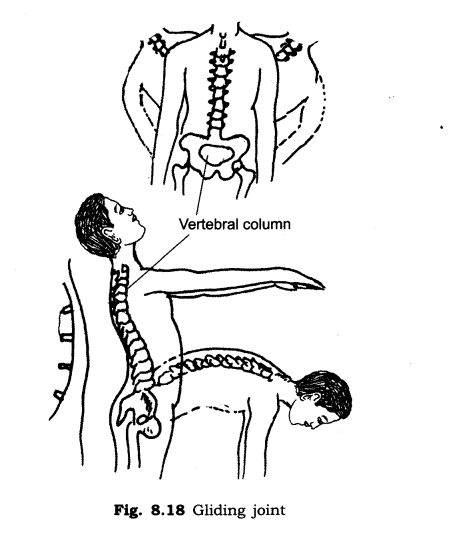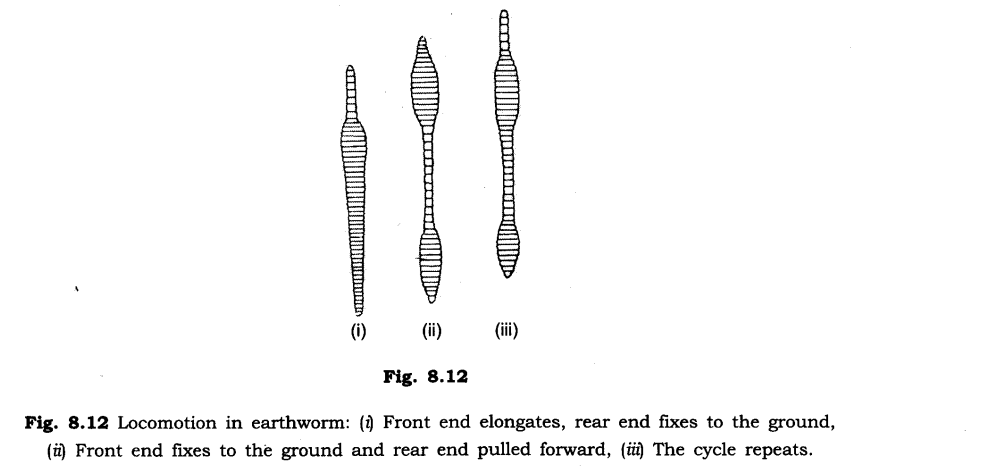4. Fixed joints: Those joints which do not allow movement are called fixed joint.
5. Gliding joint: These joints allow only a limited amount of movement of sliding nature of cartilage. For example, the joints of backbone.
Ans: The hollow or pit like space in the bone is called cavity.
Q. What do you mean by fractured bone? Why are fractured bones plastered?
Ans: Fractured bone means the broken bone.
Plaster checks the movement between broken parts and keeps broken bones at their right place so that they join properly.
Q. What are bones?
Ans: The hard, strong and non flexible internal part of the body d is known as bone.
Bones are hard and shows inflexibility so that a bone cannot be bent.
Q. What are cartilages?
Ans: Some parts of the skeleton are not as hard as bones and shows elasticity and can be bent are called cartilages, e.g. cartilage of ear.
Q. Write the differences between bones and cartilage.
Ans:
| Bone | Cartilage |
| (i) They are hard. | (i) They are soft. |
| (ii) They cannot bend. | (ii) They can bend. |
| (iii) They are used to make the framework of whole body. | (iii) They help to make some parts of the body. |
Ans:
(i) We can know the shape of skeleton by feeling of tuch.
(ii) We could know the shape by X-ray images of human body
Q. What do you mean by movement?
Ans: The changing position or any part of the body is called movement.
Q. Why do we need two types of muscles together to move a bone?
Ans: A muscle can only pull, it cannot push. Thus, two muscles are required to work together to move a bone. When one muscle contracts, the bone is pulled. When another group of muscle of the pair pulls, it brings the bone in its original position.
Ans: Mind it that a muscle can only pull. It cannot push.
The muscles work in two groups. When one of them contracts, the bone is pulled in desirable direction, the other group of muscle relaxes at this time.
At the time of movement of the bone in the opposite direction, the relaxed group of muscle contracts to pull the bone towards its original position, while the other one group relaxes.
Q. Many people suffer from a problem called arthritis. Explain its connection with movement.
Ans: Arthritis is the pain in joints. With this problem people find difficulty in moving from one place to another.
Q. How does the earthworm move?
Ans: Earthworm does not have bones. It has muscles which help to extend and shorten the body during movement.
At the time of the movement, earthworm first extends front part of the body keeping the rear portion fixed to the ground. Then it fixes the front and releases the rear end.
It then shortens the body and pulls the rear end forward. This makes it move forward by a small distance.
In this way by repeating such muscular expansions and contractions earthworm moves. The body secretes a slimy substance to help the movement.

Q. How the earthworm moves under the ground?
Ans. Earthworm has a large number of tiny hair like structures called bristles projecting out of the body. The bristles are connected with muscles and help to get a good grip on the ground.
Q. How the the earthworm make the soil fertile?
Ans. The earthworm, actually, eats its way through the soil and throws away the undigested part of the material that it eats. This activity of an earthworm makes the soil more useful for plants.
It increase the fertility of the soil so that the earthworms are called the friends of the farmers.
Q. How does the snail move?
Ans: The rounded structure on the back of the snail is called shell. It is the outer skeleton (exoskeleton) of snail.
When it starts moving a thick structure of the body, the head of the snail come out of an opening in the shell. The thick structure is called foot, made up of strong muscles. It helps snail in moving. It fix the foot and then dreag the shell. This makes it move forward by a small distance.
Q. How the cockroach moves?
Ans. Cockroaches walk, climb as well as fly in the air. They have three pairs of legs to walk. The body is covered with a hard outer skeleton.
The cockroaches have distinct muscles near the legs helps to move the legs for walking. There are two pairs of wings attached to the breast. The breast muscles move the wings to flies.
Q. What do you mean by streamlined ?
Ans: If the shape of the body is smaller at both the ends than the middle portion of the body like boat is called streamlined.
The shape of a boat, fish and birds are streamlined.
The streamlined shape can flow around it easily and allow the fish to move in water.
The head and tail of the fish are smaller than the middle portion of the body the body tapers at both ends. This body shape is called streamlined.
Q. How is a bird’s body adapted for flying?
Ans: Birds can fly in the air and walk on the ground. Some birds like ducks and swans also swim in water.
The birds can fly because their bodies are well adopted for flying. Their bones are hallow and light. The bones of the hind limbs are typical for walking and perching. The shoulder bones are strong. The bony parts of the forelimbs are modified as wings.
The breast bones are modified to hold muscles of flight which are used to move the wings up and down.
In short we can say that the following adaptations are seen in the body of birds.
(i) Bones are hollow.
(ii) Forelimbs are modified into wings.
(iii) Body is streamlined.
Q. How does fish move in water?
Ans: The body of fish is streamlined. The streamlined shape is such that water can flow around it easily and helps and allow the fish to swim in water.
The skeleton of the fish is covered with strong muscles. During swimming, muscles make the front part of the body fish curve to one side and the tail part swings towards the opposite side.
The fish forms a curve as shown in Figure. Then, quickly, the body and tail curve to the other side. This makes a jerk and pushes the body forward. A series of such jerks make the fish swim ahead. This is helped by the fins of the tail.
Q. Can bones be bent?
Ans: No, bones cannot be bent.
Q. Which parts of the body help in movement.
Ans: Contraction and relaxation of muscles, bones and joints help in movement.
Q. Write the name of an animal which can walk, climb and fly in the air.
Ans: Cockroaches.
















Post a Comment
Post a Comment